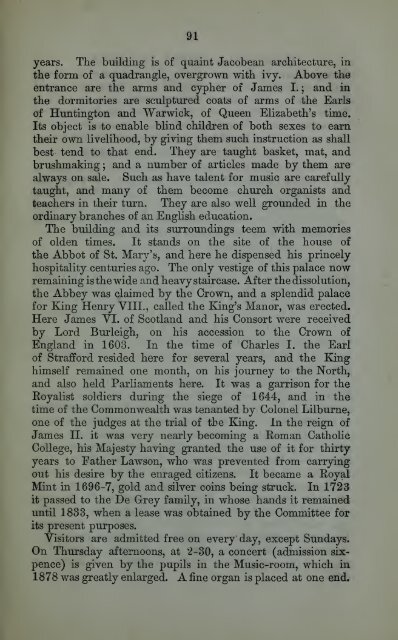practicalguideto00unse_0
Create successful ePaper yourself
Turn your PDF publications into a flip-book with our unique Google optimized e-Paper software.
91<br />
years. The building is of quaint Jacobean arcliitecture, in<br />
tlie form of a quadrangle, overgrown with ivy. Above the<br />
entrance are the arms and cypher of James I. ; and in<br />
the dormitories are sculptured coats of arms of the Earls<br />
of Huntington and Warwick, of Queen Elizabeth's time.<br />
Its object is to enable blind children of both sexes to earn<br />
their own livelihood, by giving them such instruction as shall<br />
best tend to that end. They are taught basket, mat, and<br />
brushmaking ; and a number of articles made by them are<br />
always on sale. Such as have talent for music are carefully<br />
taught, and many of them become church organists and<br />
teachers in their turn. They are also well grounded in the<br />
ordinary branches of an English education.<br />
The building and its surroundings teem with memories<br />
of olden times. It stands on the site of the house of<br />
the Abbot of St. Mary's, and here he dispensed his princely<br />
hospitality centuries ago. The only vestige of this palace now<br />
remaining is the wide and heavy staircase. After the dissolution,<br />
the Abbey was claimed by the Crown, and a splendid palace<br />
for King Henry YHL, called the King's Manor, was erected.<br />
Here James YI. of Scotland and his Consort were received<br />
by Lord Burleigh, on his accession to the Crown of<br />
England in 1603. In the time of Charles I. the Earl<br />
of Strafford resided here for several years, and the King<br />
himself remained one month, on his journey to the North,<br />
and also held Parliaments here. It was a garrison for the<br />
Eoyalist soldiers during the siege of 1644, and in the<br />
time of the Commonwealth was tenanted by Colonel Lilburne,<br />
one of the judges at the trial of the King. In the reign of<br />
James II. it was very nearly becoming a Eoman Catholic<br />
College, his Majesty having granted the use of it for thirty<br />
years to Father Lawson, who was prevented from carrying<br />
out his desire by the enraged citizens. It became a Eoyal<br />
Mint in 1696-7, gold and silver coins being struck. In 1723<br />
it passed to the De Grey family, in whose hands it remained<br />
until 1833, when a lease was obtained by the Committee for<br />
its present purposes.<br />
Visitors are admitted free on every day, except Sundays.<br />
On Thursday afternoons, at 2-30, a concert (admission sixpence)<br />
is given by the pupils in the Music-room, which in<br />
1878 was greatly enlarged. A fine organ is placed at one end.















